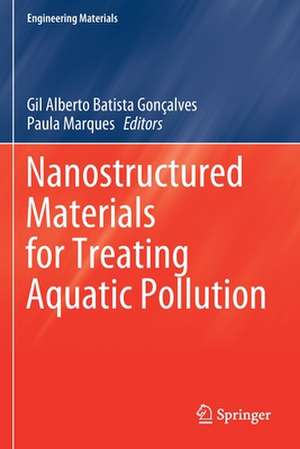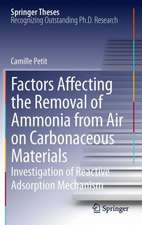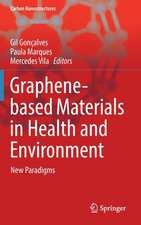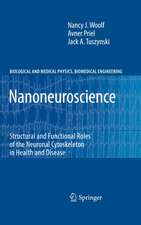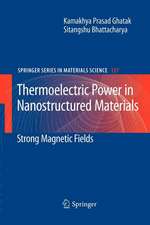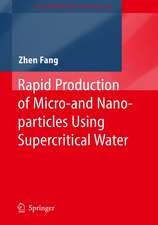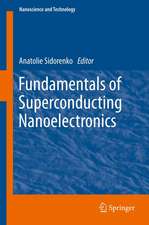Nanostructured Materials for Treating Aquatic Pollution: Engineering Materials
Editat de Gil Alberto Batista Gonçalves, Paula Marquesen Limba Engleză Paperback – 2 ian 2021
| Toate formatele și edițiile | Preț | Express |
|---|---|---|
| Paperback (1) | 641.38 lei 6-8 săpt. | |
| Springer International Publishing – 2 ian 2021 | 641.38 lei 6-8 săpt. | |
| Hardback (1) | 647.59 lei 6-8 săpt. | |
| Springer International Publishing – 2 ian 2020 | 647.59 lei 6-8 săpt. |
Din seria Engineering Materials
- 18%
 Preț: 1390.89 lei
Preț: 1390.89 lei - 18%
 Preț: 891.33 lei
Preț: 891.33 lei - 15%
 Preț: 703.85 lei
Preț: 703.85 lei - 18%
 Preț: 892.90 lei
Preț: 892.90 lei - 20%
 Preț: 573.70 lei
Preț: 573.70 lei - 24%
 Preț: 829.34 lei
Preț: 829.34 lei -
 Preț: 343.98 lei
Preț: 343.98 lei - 18%
 Preț: 1001.02 lei
Preț: 1001.02 lei - 18%
 Preț: 1396.43 lei
Preț: 1396.43 lei - 18%
 Preț: 946.55 lei
Preț: 946.55 lei - 18%
 Preț: 1120.99 lei
Preț: 1120.99 lei - 18%
 Preț: 1384.75 lei
Preț: 1384.75 lei - 18%
 Preț: 1236.99 lei
Preț: 1236.99 lei - 17%
 Preț: 490.22 lei
Preț: 490.22 lei - 15%
 Preț: 658.05 lei
Preț: 658.05 lei - 18%
 Preț: 1106.00 lei
Preț: 1106.00 lei - 18%
 Preț: 1101.26 lei
Preț: 1101.26 lei - 18%
 Preț: 1111.85 lei
Preț: 1111.85 lei - 18%
 Preț: 1002.61 lei
Preț: 1002.61 lei - 18%
 Preț: 889.75 lei
Preț: 889.75 lei - 18%
 Preț: 997.09 lei
Preț: 997.09 lei - 17%
 Preț: 428.09 lei
Preț: 428.09 lei - 15%
 Preț: 644.95 lei
Preț: 644.95 lei -
 Preț: 388.44 lei
Preț: 388.44 lei - 20%
 Preț: 566.85 lei
Preț: 566.85 lei - 18%
 Preț: 949.42 lei
Preț: 949.42 lei - 15%
 Preț: 631.72 lei
Preț: 631.72 lei - 15%
 Preț: 640.88 lei
Preț: 640.88 lei - 15%
 Preț: 635.47 lei
Preț: 635.47 lei - 18%
 Preț: 1233.20 lei
Preț: 1233.20 lei - 18%
 Preț: 1548.11 lei
Preț: 1548.11 lei - 18%
 Preț: 1126.03 lei
Preț: 1126.03 lei - 15%
 Preț: 638.11 lei
Preț: 638.11 lei - 15%
 Preț: 637.46 lei
Preț: 637.46 lei - 18%
 Preț: 1217.10 lei
Preț: 1217.10 lei - 18%
 Preț: 945.62 lei
Preț: 945.62 lei - 18%
 Preț: 948.61 lei
Preț: 948.61 lei - 18%
 Preț: 1224.54 lei
Preț: 1224.54 lei -
 Preț: 367.93 lei
Preț: 367.93 lei - 15%
 Preț: 639.25 lei
Preț: 639.25 lei - 15%
 Preț: 643.34 lei
Preț: 643.34 lei - 18%
 Preț: 955.08 lei
Preț: 955.08 lei - 15%
 Preț: 645.79 lei
Preț: 645.79 lei - 18%
 Preț: 1237.30 lei
Preț: 1237.30 lei - 18%
 Preț: 1114.34 lei
Preț: 1114.34 lei - 18%
 Preț: 1217.10 lei
Preț: 1217.10 lei - 15%
 Preț: 651.19 lei
Preț: 651.19 lei
Preț: 641.38 lei
Preț vechi: 754.56 lei
-15% Nou
Puncte Express: 962
Preț estimativ în valută:
122.74€ • 126.63$ • 103.88£
122.74€ • 126.63$ • 103.88£
Carte tipărită la comandă
Livrare economică 05-19 martie
Preluare comenzi: 021 569.72.76
Specificații
ISBN-13: 9783030337476
ISBN-10: 3030337472
Pagini: 306
Ilustrații: VIII, 306 p.
Dimensiuni: 155 x 235 mm
Greutate: 0.45 kg
Ediția:1st ed. 2019
Editura: Springer International Publishing
Colecția Springer
Seria Engineering Materials
Locul publicării:Cham, Switzerland
ISBN-10: 3030337472
Pagini: 306
Ilustrații: VIII, 306 p.
Dimensiuni: 155 x 235 mm
Greutate: 0.45 kg
Ediția:1st ed. 2019
Editura: Springer International Publishing
Colecția Springer
Seria Engineering Materials
Locul publicării:Cham, Switzerland
Cuprins
Nanostructured graphene-based materials for adsorption of heavy metals from contaminated water.- Nanostructured graphene-based materials for adsorption of organic compounds from water.- Nanostructured catalytic materials for the degradation of organic pollutants in aqueous medium.- Nanostructured metallic oxides for waters remediation.- Nanostructured polymers composites for water remediation.-Nanostructured materials for water desalination.- Nanostructured antibacterial materials for water decontamination.- Nanostructured sensors for water quality monitorization.- Biological assessment of the impact of nanostructured materials in aquatic environments.- Water remediation nanotechnologies available on market.- Sustainable management of water resources.
Notă biografică
Gil Gonçalves graduated in 2003 in Industrial Chemistry at University of Aveiro (Portugal) and obtained a Master degree in Materials Science (EMMS, Joint European Master's Programme) in 2008. In 2012 he received his PhD in Mechanical Engineering at the University of Aveiro with a thesis dedicated to nanocomposite materials for biomedical applications. Between 2012-2016 he worked at University of Aveiro as a Postdoctoral fellow on the development of new graphene-based nanocomposite materials with application on many different fields: Graphene based porous structures for heterogeneous catalysis (Catalysis) and water purification (Environment), three-dimensional graphene scaffolds for biomedical applications (Biomaterials), nanostructured graphene substrates for selective biomolecules detection (Sensors) and carbon-based nanoplatforms for detection and therapy of cancer (Therapeutic agent). After obtaining a Marie Curie research fellowship in 2016, he started working at the Institute of Material Science of Barcelona-High Council of Spanish Research (ICMAB-CSIC) on the development of ultra-sensitive nanotherapeutic anticancer agents for neutron capture therapy. Currently, he is working as Assistant Researcher at TEMA - Centre for Mechanical Technology and Automation (Portugal), on the development of new carbon nanocapsules for cancer theranostic applications. He is also a member of the editorial board of Nature Publishing Group’s Scientific Reports in the field of Chemical Physics. Paula Marques graduated in Chemistry in 1993 in the University of Aveiro (UA), Portugal, then completing in 1997 her Master’s in Chemistry and Physics Teaching and in 2003 her PhD degree in Materials Science Engineering, with specialization in Biomaterials, at the same institution, followed by post-doctoral activities at Materials and Ceramic Engineering and Chemistry Departments at UA. From November 2007 to December 2013, Paula was an Auxiliary Researcher at TEMA - Centre for Mechanical Technology and Automation - Mechanical Engineering Department (DEM) at UA and since January 2014 she has been a Principal Researcher at the same institution.
The scientific interests of Paula comprise the engineering and development of new nanostructured materials that may give answers to societal challenges. Since entering TEMA research unit, Paula started working with carbon nanostructures. At that time (2007) there was a boom on the research related to graphene discovery that culminated with the Nobel Physics award to Andre Geim and Konstantin Novoselov in 2010. By the time of that occasion, Paula started exploring a graphene derivative: graphene oxide (GO), which she found to be an amazing versatile nanomaterial with huge potential for the development of novel nanocomposites. From then and until now, she has been exploring this nanomaterial for numerous applications, such as: (i) nanocomposites based on GO/noble metal nanoparticles as probes for biosensors; (ii) functionalized nano-GO for cell uptake studies aimed at near-infrared mediated tumour hyperthermia; (iii) mechanical and electrical stimulus responsive 3D GO-based scaffolds for tissue engineering; (iv) functional GO-based foams for water remediation; (v) electrospun GO/polymer fibres mats for photocatalytic air filters; (vi) functionalized GO as mechanical reinforcement of polymer matrixes.
Paula has a long experience in projects participation. Presently she is coordinator of H2OValue – Graphene based materials and water remediation: a sustainable solution for a real problem? CENTRO-01-0145-FEDER-030513, co-coordinator of Cartilfactory – Development and construction of a large-scale engineered cartilage-like manufacturing-system combining electrospinning of chondrocyte-laden 3D scaffolds with direct 3D cell expansion and mechanical-stimulus on bioreactor. POCI-01-0145-FEDER-028424 and participant in BrightCD -Carbon Nanodots: who is the brightest of them all?, PTDC/NAN-MAT/29317/2017 (National Funding). Recently, Paula was award with a H2020 FETOPEN-RIA-2018 project: NeuroStimSpinal – A step forward to spinal cord injury repair using innovative stimulated nanoengineered scaffolds, being the Project Coordinator.
The scientific interests of Paula comprise the engineering and development of new nanostructured materials that may give answers to societal challenges. Since entering TEMA research unit, Paula started working with carbon nanostructures. At that time (2007) there was a boom on the research related to graphene discovery that culminated with the Nobel Physics award to Andre Geim and Konstantin Novoselov in 2010. By the time of that occasion, Paula started exploring a graphene derivative: graphene oxide (GO), which she found to be an amazing versatile nanomaterial with huge potential for the development of novel nanocomposites. From then and until now, she has been exploring this nanomaterial for numerous applications, such as: (i) nanocomposites based on GO/noble metal nanoparticles as probes for biosensors; (ii) functionalized nano-GO for cell uptake studies aimed at near-infrared mediated tumour hyperthermia; (iii) mechanical and electrical stimulus responsive 3D GO-based scaffolds for tissue engineering; (iv) functional GO-based foams for water remediation; (v) electrospun GO/polymer fibres mats for photocatalytic air filters; (vi) functionalized GO as mechanical reinforcement of polymer matrixes.
Paula has a long experience in projects participation. Presently she is coordinator of H2OValue – Graphene based materials and water remediation: a sustainable solution for a real problem? CENTRO-01-0145-FEDER-030513, co-coordinator of Cartilfactory – Development and construction of a large-scale engineered cartilage-like manufacturing-system combining electrospinning of chondrocyte-laden 3D scaffolds with direct 3D cell expansion and mechanical-stimulus on bioreactor. POCI-01-0145-FEDER-028424 and participant in BrightCD -Carbon Nanodots: who is the brightest of them all?, PTDC/NAN-MAT/29317/2017 (National Funding). Recently, Paula was award with a H2020 FETOPEN-RIA-2018 project: NeuroStimSpinal – A step forward to spinal cord injury repair using innovative stimulated nanoengineered scaffolds, being the Project Coordinator.
Textul de pe ultima copertă
This book report the advances in the synthesis of new nanomaterials for the remediation of natural waters, groundwaters, and wastewaters. The authors describe synthetic routes for the assembly of different nanomaterials for the removal of contaminants by adsorption, catalytic degradation, and antibacterial activity. The hazardous effects of nanomaterials in aquatic ecosystems are discussed. This book presents the trends in the development of advanced technologies available in the market based on nanomaterials for more efficient water remediation. The authors also discuss sustainable management of water resources according to the new technologies developed and the improved efficiency of remediation processes.
Caracteristici
Describes developments using nanotechnology for the remediation of waters Lists nanosystems water treatments available on the market Addresses the environmental impact and risks of the use of nanomaterials in aquatic ecosystems
